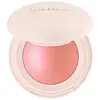What's inside
What's inside
 Key Ingredients
Key Ingredients

 Benefits
Benefits

 Concerns
Concerns

 Ingredients Side-by-side
Ingredients Side-by-side

Talc
AbrasiveMica
Cosmetic ColorantSilica
AbrasiveDiisostearyl Malate
EmollientHydrogenated Poly(C6-14 Olefin)
EmollientTriethoxycaprylylsilane
Dipentaerythrityl Hexahydroxystearate/Hexastearate/Hexarosinate
Skin ConditioningMagnesium Myristate
Octyldodecyl Stearoyl Stearate
EmollientCI 19140
Cosmetic ColorantHdi/Trimethylol Hexyllactone Crosspolymer
CI 73360
Cosmetic ColorantCI 77891
Cosmetic Colorant1,2-Hexanediol
Skin ConditioningGlyceryl Caprylate
EmollientHydrogenated Lecithin
EmulsifyingCI 15850
Cosmetic ColorantAluminum Hydroxide
EmollientDimethicone
EmollientMethicone
EmollientTalc, Mica, Silica, Diisostearyl Malate, Hydrogenated Poly(C6-14 Olefin), Triethoxycaprylylsilane, Dipentaerythrityl Hexahydroxystearate/Hexastearate/Hexarosinate, Magnesium Myristate, Octyldodecyl Stearoyl Stearate, CI 19140, Hdi/Trimethylol Hexyllactone Crosspolymer, CI 73360, CI 77891, 1,2-Hexanediol, Glyceryl Caprylate, Hydrogenated Lecithin, CI 15850, Aluminum Hydroxide, Dimethicone, Methicone
Synthetic Fluorphlogopite
Dimethicone
EmollientDimethicone/Vinyl Dimethicone Crosspolymer
Skin ConditioningOctyldodecyl Stearoyl Stearate
EmollientTapioca Starch
Boron Nitride
AbsorbentOctyldodecanol
EmollientDiisostearyl Malate
EmollientSilica
Abrasive1,2-Hexanediol
Skin ConditioningCaprylyl Glycol
EmollientTin Oxide
AbrasivePolymethylsilsesquioxane
CI 77891
Cosmetic ColorantCI 77491
Cosmetic ColorantCI 15850
Cosmetic ColorantCI 19140
Cosmetic ColorantSynthetic Fluorphlogopite, Dimethicone, Dimethicone/Vinyl Dimethicone Crosspolymer, Octyldodecyl Stearoyl Stearate, Tapioca Starch, Boron Nitride, Octyldodecanol, Diisostearyl Malate, Silica, 1,2-Hexanediol, Caprylyl Glycol, Tin Oxide, Polymethylsilsesquioxane, CI 77891, CI 77491, CI 15850, CI 19140
Ingredients Explained
These ingredients are found in both products.
Ingredients higher up in an ingredient list are typically present in a larger amount.
1,2-Hexanediol is a synthetic liquid and another multi-functional powerhouse.
It is a:
- Humectant, drawing moisture into the skin
- Emollient, helping to soften skin
- Solvent, dispersing and stabilizing formulas
- Preservative booster, enhancing the antimicrobial activity of other preservatives
Ci 15850 is the pigment color red. It is an azo dye and created synthetically.
Azo dyes need to be thoroughly purified before use. This allows them to be more stable and longer-lasting.
This ingredient is common in foundations, lipsticks, and blushes. This color is described as brown/orangey red.
It has many secondary names such as Red 6 and Red 7. According to a manufacturer, Red 6 usually contains aluminum.
Learn more about CI 15850CI 19140 is also known as Tartrazine. Tartrazine is a synthetic dye used in cosmetics, foods, and medicine to add a yellow color.
Tartrazine is created from petroleum and is water-soluble.
Some people may experience allergies from this dye, especially asthmatics and those with an aspirin intolerance.
Learn more about CI 19140Ci 77891 is a white pigment from Titanium dioxide. It is naturally found in minerals such as rutile and ilmenite.
It's main function is to add a white color to cosmetics. It can also be mixed with other colors to create different shades.
Ci 77891 is commonly found in sunscreens due to its ability to block UV rays.
Learn more about CI 77891Diisostearyl Malate is an emollient and most often used in lip products. It comes from isostearyl alcohol, a fatty acid, and malic acid, an AHA.
As an emollient, Diisostearyl Malate helps create a thin film on your skin to trap moisture in. This helps keep your skin soft and smooth.
Dimethicone is a type of synthetic silicone created from natural materials such as quartz.
What it does:
Dimethicone comes in different viscosities:
Depending on the viscosity, dimethicone has different properties.
Ingredients lists don't always show which type is used, so we recommend reaching out to the brand if you have questions about the viscosity.
This ingredient is unlikely to cause irritation because it does not get absorbed into skin. However, people with silicone allergies should be careful about using this ingredient.
Note: Dimethicone may contribute to pilling. This is because it is not oil or water soluble, so pilling may occur when layered with products. When mixed with heavy oils in a formula, the outcome is also quite greasy.
Learn more about DimethiconeOctyldodecyl Stearoyl Stearate is created from stearic acid.
It is an emollient and thickens the lipid (oil) portion of a product. Due to its emollient properties, it may not be fungal-acne safe.
Silica, also known as silicon dioxide, is a naturally occurring mineral. It is used as a fine, spherical, and porous powder in cosmetics.
Though it has exfoliant properties, the function of silica varies depending on the product.
The unique structure of silica enhances the spreadability and adds smoothness, making it a great texture enhancer.
It is also used as an active carrier, emulsifier, and mattifier due to its ability to absorb excess oil.
In some products, tiny microneedles called spicules are made from silica or hydrolyzed sponge. When you rub them in, they lightly polish away dead skin layers and enhance the penetration of active ingredients.
Learn more about Silica